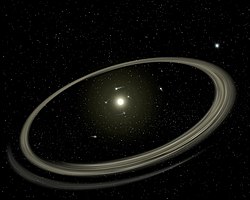
Back Planetensystem ALS نظام كوكبي Arabic Sistema planetariu AST Планетная сістэма Byelorussian Плянэтная сыстэма BE-X-OLD Планетарна система Bulgarian গ্রহ ব্যবস্থা Bengali/Bangla Sistema planetari Catalan سیستمی ھەسارەیی CKB Planetární soustava Czech

A planetary system consists of a set of non-stellar bodies which are gravitationally bound to and in orbit of a star or star system. Generally speaking such systems will include planets, though may also include other objects such as dwarf planets, asteroids, natural satellites, meteoroids, comets, planetesimals[1][2] and circumstellar disks. The Solar System is an example of a planetary system, in which Earth and a number of other planets and celestial objects are bound to and revolve around the Sun.[3][4] The term exoplanetary system is sometimes used in reference to planetary systems other than that of the Solar System. By convention planetary systems are named after their host, or parent, star, as is the case with the Solar System being named after "Sol" (Latin for sun).
As of 17 April 2025, there are 5,943 confirmed exoplanets in 4,461 planetary systems, with 976 systems having more than one planet.[5] Debris disks are known to be common while other objects are more difficult to observe.
Of particular interest to astrobiology is the habitable zone of planetary systems where planets could have surface liquid water, and thus, the capacity to support Earth-like life.
- ^ Darling, David J. (2004). The universal book of astronomy: from the Andromeda Galaxy to the zone of avoidance. Hoboken (NJ): Wiley. p. 394. ISBN 978-0-471-26569-6.
- ^ Illingworth, Valerie, ed. (2000). Collins dictionary astronomy (2 ed.). Glasgow: HarperCollins. p. 314. ISBN 978-0-00-710297-6.
- ^ p. 382, Collins Dictionary of Astronomy.
- ^ Ridpath, Ian, ed. (2003). A dictionary of astronomy. Oxford paperback reference (Rev. ed.). Oxford ; New York: Oxford University Press. p. 420. ISBN 978-0-19-860513-3.
- ^ Schneider, J. "Interactive Extra-solar Planets Catalog". The Extrasolar Planets Encyclopedia. Retrieved April 17, 2025.
© MMXXIII Rich X Search. We shall prevail. All rights reserved. Rich X Search